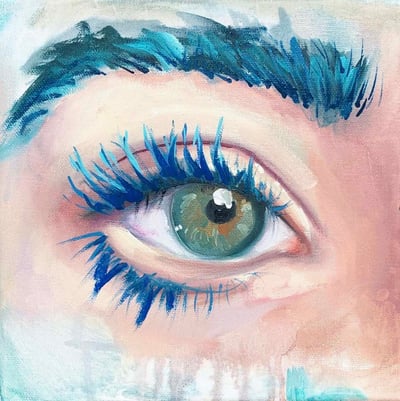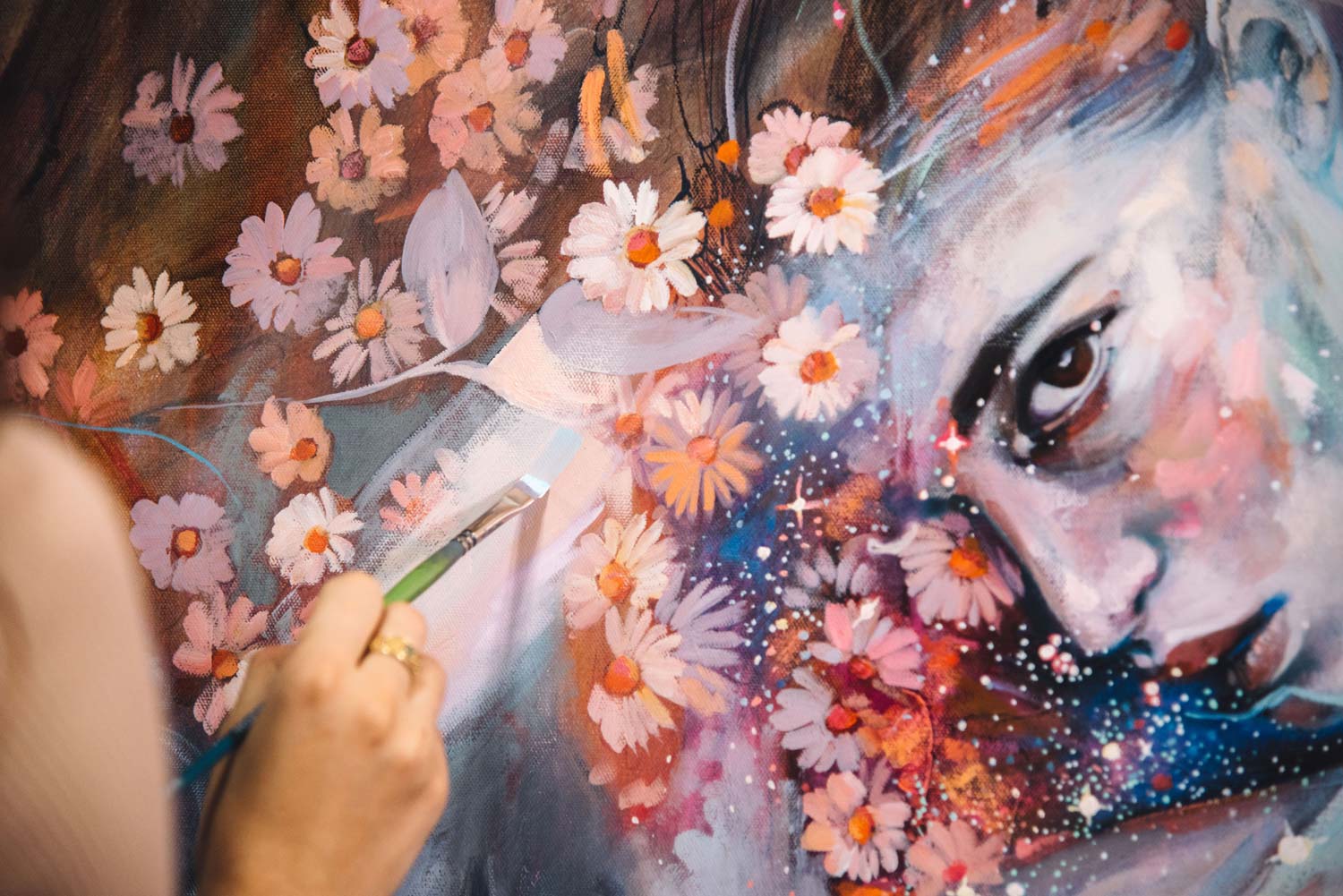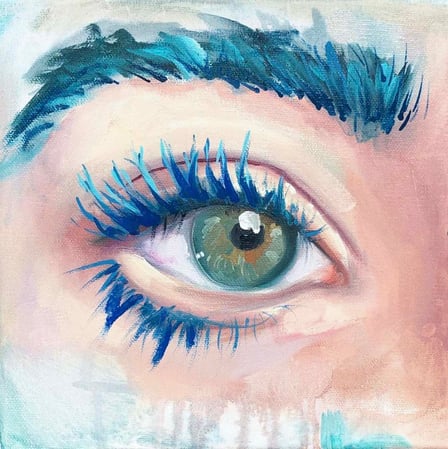Have you ever tried to paint eyes that look at you, and they end up looking in two different directions, scaring away your mother and grandma?
Yep, same.
This practical and comprehensive guide on how to paint eyes for beginners will surely help you out of your slump of painting cross-eyed models! Keep reading if you want to learn how to paint eyes like a pro.

The Anatomy of an Eye
The anatomy of the eye is not as tricky as you may think, but understanding the different shapes and curves is key when painting a realistic eye.
Most eyes generally have an almond shape, but some can be more or less rounded.
The iris is the part of the eye that will direct the gaze. Each iris in a pair of eyes has a very specific angle to it.
In order to get two matching eyes looking in the same direction, you have to measure the angle from the highest point to the lowest point.
Those two points should be opposite of eachother, and knowing this angle will help you map out the shape and location of your iris.
The tear duct is another important part of drawing an eye. You want to make sure it is rounded, and the transition into the bottom and top eyelid is smooth.
How to paint Eyes Easy: Best Techniques
You can paint an eye using any technique and medium you are comfortable with.
I personally enjoy the alla prima process (“at first attempt”) meaning it is done in one sitting, with one layer, fairly quickly. You can do this technique with acrylic or oils.
Oil Painting

When you paint eyes in oil, it is very helpful to first do a thin wash over the whole canvas to get rid of the white. A very thin drippy layer of any light color works perfect for this.
You can get the paint to be thin and drippy by mixing paint thinner into the paint, and of course, by using a large brush.
The next step is etching in the outer contour of the eye. Use a small brush that comes to a point to create this.
Mix a darker color with paint thinner, and use this small, round and pointy brush to sketch out the outer lines of the eye. From the tear duct, you should have a straight line slightly tilted, then a soft curved line that will connect to the back corner of the eye.
The bottom line is much softer, and will swoop under the eye and connect again to the tear duct and back corner. Next, sketch in the iris, and the crease above the top eyelid.
Once you have the outer contour sketched in, you will want to use a medium sized brush to block in all the larger areas with a value between 6-10. These are all the darkest darks! That would be the pupil, creases, under the eyelid.
Then continue with this process until you have blocked in the midtones and highlights. If you want to watch a pro use this process in a portrait, check out Portrait Painting Essentials.
You will be able to keep the paint fluid by mixing a medium into it, such as linseed oil or galkyd.
When painting the whites of the eye, the biggest mistake most artists make is using straight white paint. You will never use straight white paint ever, but especially not in the whites of the eye.
The whites of the eyes will always be tinted, depending on the lighting situation in the source or on the live model you are painting. If you are trying to paint an eye out of your head, mixing paynes grey or brown pink are usually a safe bet.
The whites of the eyes can have a blue/grey tint to them, or a more red tint. If you’re painting out of your head, it’s up to you! It will always be a little more colorful along the edges and at the corners, and a brighter white near the iris.
Acrylic Painting
When you paint eyes, acrylic paint can also be used in the process of alla Prima. Alla prima painting is actually very easy with acrylics, as they dry at lightning speed compared to oils.
However, the concept is still the same with acrylics as it is with oils! The only difference is you’ll be using water instead of paint thinner, and mixing in retarder instead of galkyd.
Be sure to have out a good variety of brushes and colors on your palette. Once you finish any paintings of eyes with acrylic paint, use transparent oil colors to glaze over the acrylic.
Glazing is done by using transparent paint and a medium to help keep it fluid. It will be transparent over what you have painted, while giving the piece more depth and saturation.
How to Add the Iris and Reflection Area
Adding tiny details to a painting of an eye can be difficult depending on how large the eye is! If you are working smaller, make sure the brush you are using is suited for tiny details, such as the iris, the sparkle, and any reflections you can see.
When you paint the iris, paint it in several layers. Your first layer should be the darkest color shown in the eye.
Once you have that down, use a small brush to create the beautiful lighter colorful streaks in the eye.
Continue working from dark to light, so don’t go straight to the brightest highlights after that first dark layer. A size 4 filbert is a great brush to use for the inner streaks of color, as you can get a decent variety of widths.
When adding any small and bright details to a painting, make sure your brush is clean from any other paint colors. When mixing your bright color for the highlight on the eye, the paint should sit on top of the tip of the brush.
Do not press the paint into the brush as you mix, because in order to transfer that paint to your painting, you will have to press and smudge the brush, and this will create a less than desirable effect.
Lightly mix and scoop the mixed color onto the tip of the brush. Then let the brush lightly kiss the canvas to add that teensie sparkle in the eye.
The bright color will not mix with any of the darks you applied earlier, and your sparkle won’t be too large and smudgy.
Adding Eyelashes
Painting the eyelashes to a painting of an eye is like adding the cherry on top of an ice cream sundae. It's so satisfying and fun!
The most important part about painting eyelashes is the brush you use. I highly recommend investing in a good quality script brush, and keeping it clean and fresh! There’s nothing worse than a script brush that has frayed bristles going in every direction.
When you paint the eyelashes, always start from under the eyelid. Creating the swoop, you will actually bring your brush down from under the eyelid then a big swoop up. If you immediately swoop up, it will have very little dimension to it and won’t look very realistic.
Once you have those eyelashes in, you’re golden! You’ve now painted a whole eye, and I bet it looks amazing.
By following a few key steps and understanding what makes an eye painting look good, you can fulfill your wildest dreams of knowing how to paint realistic eyes, as well as painting anything else under the sun.
The world is your oyster!
Use the hashtag #milanartinstitute to show us those eyeballs! Happy painting!

